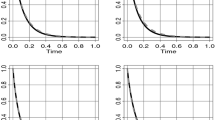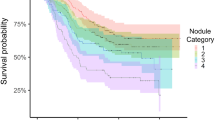Abstract
The development of models and methods for cure rate estimation has recently burgeoned into an important subfield of survival analysis. Much of the literature focuses on the standard mixture model. Recently, process-based models have been suggested. We focus on several models based on first passage times for Wiener processes. Whitmore and others have studied these models in a variety of contexts. Lee and Whitmore (Stat Sci 21(4):501–513, 2006) give a comprehensive review of a variety of first hitting time models and briefly discuss their potential as cure rate models. In this paper, we study the Wiener process with negative drift as a possible cure rate model but the resulting defective inverse Gaussian model is found to provide a poor fit in some cases. Several possible modifications are then suggested, which improve the defective inverse Gaussian. These modifications include: the inverse Gaussian cure rate mixture model; a mixture of two inverse Gaussian models; incorporation of heterogeneity in the drift parameter; and the addition of a second absorbing barrier to the Wiener process, representing an immunity threshold. This class of process-based models is a useful alternative to the standard model and provides an improved fit compared to the standard model when applied to many of the datasets that we have studied. Implementation of this class of models is facilitated using expectation-maximization (EM) algorithms and variants thereof, including the gradient EM algorithm. Parameter estimates for each of these EM algorithms are given and the proposed models are applied to both real and simulated data, where they perform well.
Similar content being viewed by others
References
Aalen OO (1992) Modelling heterogeneity in survival analysis by the compound Poisson distribution. Ann Appl Probab 2: 951–972
Aalen OO (1994) Effects of frailty in survival analysis. Stat Methods Med Res 3: 227–243
Aalen OO, Gjessing HK (2001) Understanding the shape of the hazard rate: a process point of view. Stat Sci 16: 1–22
Achcar J, Araujo Pereira G (1999) Mixture models for type II censored survival data in the presence of covariates. Comput Stat 14: 233–250
Berkson J, Gage RP (1952) Survival curve for cancer patients following treatment. J Am Stat Assoc 47: 501–515
Boag JW (1949) Maximum likelihood estimates of the proportion of patients cured by cancer therapy. J R Stat Soc B 11: 15–34
Cantor AB, Shuster JJ (1992) Parametric versus non-parametric methods for estimating cure rates based on censored survival data. Stat Med 11: 931–937
Chen M-H, Ibrahim JG, Sinha D (1999) A new Bayesian model for survival data with a surviving fraction. J Am Stat Assoc 94: 909–919
Chhikara RS, Folks JL (1978) The inverse Gaussian distribution and its statistical application-a review. J R Stat Soc B 40: 263–289
Cox DR (1972) Regression models and life-tables (with discussion). J R Stat Soc B 34: 187–220
Cox DR (1999) Some remarks on failure-times, surrogate markers, degradation, wear, and the quality of life. Lifetime Data Anal 5: 307–314
Dempster AP, Laird NM, Rubin DB (1977) Maximum likelihood from incomplete data via the EM algorithm (with discussion). J R Stat Soc B 39: 1–38
Desmond AF, Chapman GR (1992) Likelihood inference for inverse Gaussian mixtures. Technical report, Department of Mathematics and Statistics, University of Guelph, Ontario, Canada
Desmond AF, Chapman GR (1993) Modelling task completion data with inverse Gaussian mixtures. Appl Stat 42(4): 603–613
Desmond AF, Yang ZL (2006) Score tests of goodness-of-fit for the inverse Gaussian distribution. Technical report, Department of Mathematics and Statistics, University of Guelph
Duchateau L, Janssen P (2008) The frailty model. Springer, New York
Farewell VT (1982) The use of mixture models for the analysis of survival data with long-term survivors. Biometrics 38: 1041–1046
Farewell VT (1986) Mixture models in survival analysis: are they worth the risk. Can J Stat 14: 257–262
Feller W (1986) An introduction to probability theory and its applications. Wiley, New York
Gieser PW, Chang MN, Rao PV, Shuster JJ, Pullen J (1998) Modelling cure rates using the Gompertz model with covariate information. Stat Med 17: 831–839
Haybittle JL (1959) The estimation of the proportion of patients cured after treatment for cancer of the breast. Br J Radiol 32: 725–733
Ichida J, Wassell J, Keller M, Ayers L (1993) Evaluation of protocol change in burn-care management using the Cox proportional hazards model with time-dependent covariates. Stat Med 12: 301–310
Kalbfleisch JD, Prentice RL (2002) The statistical analysis of failure time data, 2nd edn. Wiley, New York
Knight F (1981) Essentials of Brownian motion and diffusion, math surveys and monographs no. 18. Amer Math Soc, Providence, Rhode Island
Kuk AYC, Chen CH (1992) A mixture model combining logistic regression with proportional hazards regression. Biometrika 79: 531–541
Kuo L, Peng F (1995) A mixture-model approach to the analysis of survival data. Technical report 95–31, Department of Statistics, University of Connecticut
Lancaster T (1972) A stochastic model for the duration of a strike. J R Stat Soc A 135: 257–271
Lange K (1995a) A gradient algorithm locally equivalent to the EM algorithm. J R Stat Soc B 57: 425–437
Lange K (1995b) A quasi-Newton acceleration of the EM algorithm. Stat Sin 5: 1–18
Lawless JF (2003) Statistical models and methods for lifetime data. 2nd edn. Wiley, New York
Lee M-LT, Whitmore GA (2004) First hitting time models for lifetime data. In: Balakrishnan N, Rao CR(eds) Handbook of statistics, vol 23. Elsevier, Amsterdam, pp 537–543
Lee M-LT, Whitmore GA (2006) Threshold regression for survival analysis: modeling event times by a stochastic process reaching a boundary. Stat Sci 21(4): 501–513
Lesosky M, Horrocks J (2004) Generating random variables from the inverse Gaussian and first-passage-two-barrier distributions. Technical report, Department of Mathematics and Statistics, University of Guelph
Longini IN, Halloran ME (1996) A frailty mixture model for estimating vaccine efficacy. Appl Stat 45: 165–173
Maller RA, Zhou X (1996) Survival analysis with long-term survivors. Wiley, West Sussex
McLachlan GJ, Krishnan T (2008) The EM algorithm and extensions, 2nd edn. Wiley, New York
Pelsser A (2000) Pricing double barrier options using laplace transforms. Finance and Stochastics 4: 95–104
Peng Y, Dear KBG (2000) A nonparametric mixture model for cure rate estimation. Biometrics 56: 237–243
Peng Y, Dear KBG, Denham JW (1998) A generalized F mixture model for cure rate estimation. Stat Med 17: 813–830
Rai SN, Matthews DE (1995) Improving the EM algorithm. Biometrics 49: 587–591
Schrödinger E (1915) Zur theorie der fall-und steigversuche an teilchen mit brownscher bewegung. Phys Ze 16: 289–295
Sy JP, Taylor JMG (2000) Estimation in a Cox proportional hazards cure model. Biometrics 56: 227–236
Taylor JMG (1995) Semi-parametric estimation in failure time mixture models. Biometrics 51: 899–907
Tweedie MCK (1945) Inverse statistical variates. Nature 155: 453
Whitmore GA (1979) An inverse Gaussian model for labour turnover. J R Stat Soc A 142: 468–478
Whitmore GA (1986) Normal-gamma mixtures of inverse Gaussian distributions. Scand J Stat 13: 211–220
Whitmore GA, Su Y (2007) Modeling low birth weights using threshold regression: results for U.S. birth data. Lifetime Data Anal 13: 161–190
Whitmore GA, Crowder MJ, Lawless JF (1998) Failure inference from a marker process based on a bivariate Wiener model. Lifetime Data Anal 4: 229–251
Yakovlev AY, Asselain B, Bardou VJ, Fourquet A, Hoang R, Rochefediere A, Tsodikov AD (1993) A simple stochastic model of tumor recurrence and its applications to data on premenopausal breast cancer. In: Asselain CDCLJPMB, Boniface M, Tranchefort J (eds) Biometrie et Analyse de Donnees Spatio-Temporelles, pp 66–82
Author information
Authors and Affiliations
Corresponding author
Rights and permissions
About this article
Cite this article
Balka, J., Desmond, A.F. & McNicholas, P.D. Review and implementation of cure models based on first hitting times for Wiener processes. Lifetime Data Anal 15, 147–176 (2009). https://doi.org/10.1007/s10985-008-9108-y
Received:
Accepted:
Published:
Issue Date:
DOI: https://doi.org/10.1007/s10985-008-9108-y




